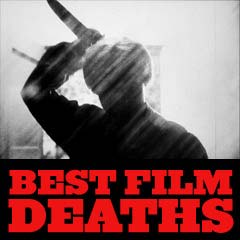
|

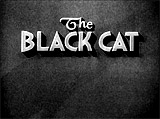
|
In revenge for his atrocities, Hjalmar Poelzig (Boris Karloff) was vengefully skinned alive (seen in dark silhouette) with a scalpel by Dr. Vitus Werdegast (Bela Lugosi). Poelzig was suspended upon and shackled to an embalming, torture rack where he was stripped of his robes and prepared for being skinned alive! With a mad, delirious gleam in his eyes, Werdegast ranted and raved about what he was planning to do to the Satanist on his own embalming rack: Do you know what I am going to do to you now? No? Did you ever see an animal skinned, Hjalmar? Ha, ha, ha. That's what I'm going to do to you now - flay/tear the skin from your body...slowly...bit by bit! From a surgical table, Werdegast selected a scalpel for the operation. Joan (Julie Bishop) screamed when she realized she would be witnessing a live skinning. Slowly and bit by bit, the doctor sliced skin with a scalpel from his face (the skinning was filmed as a dark shadow play in black images of manacled hands on the wall). He asked sadistically:
|
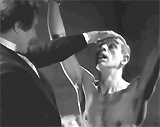 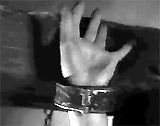  Poelzig Skinned Alive |
||||||
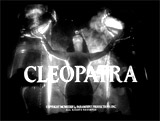
|
Queen of Egypt Cleopatra (Claudette Colbert) experienced a memorable death scene, enacted with a live snake. Realizing that she would be quickly conquered, Cleopatra was attended to by her loyal handmaidens - she was dressed in black with a low-cut decolletage. She requested a basket to be extended to her on the throne:
She reached into the basket and removed a real, one-foot long snake/asp and applied it to her naked breast in one of the most memorable suicidal death scenes in film history. She was bitten, and then expired while sitting on the throne. She sat immobile and defeated there as her kingdom was conquered. |
 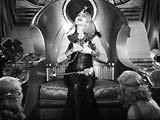 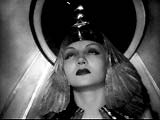 Death by Asp to Cleopatra's Breast |
||||||
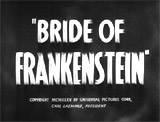
|
In the ending of this classic horror film, the Monster (Boris Karloff) spared his creator Henry Frankenstein (Colin Clive) (and Elizabeth (Valerie Hobson)) by permitting them to rush to safety outside: "Yes, go! You live! Go!" But Dr. Pretorius (Ernest Thesiger) was not allowed to join them: "You stay! We belong dead!" Then, the Monster pulled the fateful lever to bring both creatures and creator to extinction. At the same moment, the Bride (Elsa Lancaster) expelled one long, snake-like hiss at the Monster. A tear rolled down the Monster's repulsive face as he summoned a fatally-aborted 'honeymoon' night. Explosions rocked the stone-tower - rubble from the crumbling foundation buried everyone inside alive.
On a nearby hillside, Elizabeth and Henry Frankenstein (who had renounced his mad career once and for all) happily embraced as he offered comforting words to her: "Darling. Darling." |
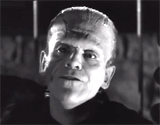 The Monster 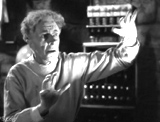 Dr. Pretorius 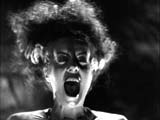 The Bride Shrieking at the Monster 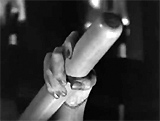 The Monster Pulling the Lever |
||||||
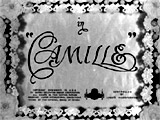
|
In a concluding soft-focus scene, consumption-wracked Marguerite 'Camille' Gautier (Greta Garbo) died in the arms of her lover Armand Duval (Robert Taylor). She had gone limp and cried that she wasn't strong enough. After Armand called for the doctor, placed her in a chaise and knelt at her side, she experienced sadness for a love that she had lost forever in the temporal world. But she was not self-deluded - her death would release them from an untenable relationship into a more spiritual, mystical relationship:
Armand embraced her as she perished, vowing:
She signaled death when her eyes burst open once. She crumbled and fell lifeless, but remained tranquil with a gentle smile on her face.
He looked at her and noticed she had already passed away. He was horrified that this was the end.
He buried his face on her breast, weeping. The film ended with a final fade-out, close-up shot of Marguerite's lovely, radiant face - imperishable in death. |
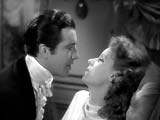  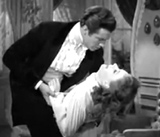 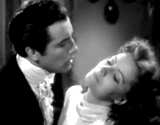 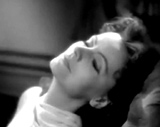 "Don't leave me." |
||||||
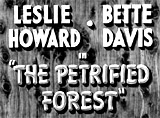
|
The Petrified Forest (1936) In the film's tearjerking finale, idealistic and disillusioned writer/world traveler Alan Squier (Leslie Howard) died in the arms of culturally-starved waitress Gabrielle "Gabby" Maple (Bette Davis). He had been shot by ruthless fugitive gangster Duke Mantee (Humphrey Bogart) in a run-down Arizona desert cafe. Before dying, he told her:
She tried to get him to continue talking ("What Alan? What did you say? Alan!"), but he was gone. She realized that he had found a purpose in his life. His life insurance policy for $5,000 had been made out in her name - allowing her the freedom to leave the town and move to France. She planned to bury Alan out in the petrified forest ("That's what he said he wanted"). Gabby then recited the film's final poetic lines, taken from "Ballad Written For a Bridegroom" (Part VI) by Victorian poet Algernon Charles Swinburne:
|
 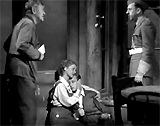 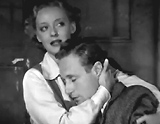 "This is the end for which we twain are met." |
||||||
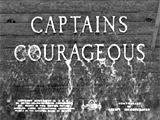
|
Portuguese fisherman Manuel (Spencer Tracy) died in fishing waters as he was cut free from the tangled mast ropes and drowned. In the climactic race back to Gloucester port against a rival schooner, the Jennie Cushman, Manuel had volunteered to climb to the top of the mast to furl the sail, but tragically was mortally injured when the mast cracked and he was plunged into the water, caught in the tangled rope and the topsail canvas. He knew he was "as good as dead. Gone, he knows it...all the bottom half of him is gone."
Just before he was cut loose of the ropes to sink below the surface to his drowning death, he delivered a memorable, sentimental, and tearful goodbye to young Harvey Cheyne (Freddie Bartholomew):
|
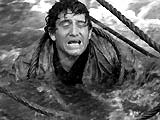 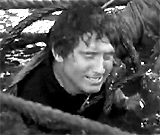 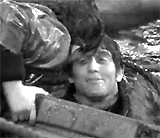 "Eh, leetle feesh." |
||||||
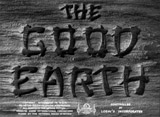
|
The Good Earth (1937) Chinese farmer Wang Lung (Paul Muni), a straying husband, came upon the deathbed of his selfless and ailing first wife O-Lan (Luise Rainer). He reached into his clothing and pulled out a pouch. He took her hand and deposited two valuable pearls in it from the bag. She was overjoyed that he had returned her pearls to her. He urged her: "You'll be well again." She sighed and said: "I'm content, and what must be done you've done." He told her that she was always the one:
He was sorrowful about her fading condition:
The two valuable pearls rolled out of her outstretched, opening hand on the bed cover. Wang quietly walked outside to an adjacent, flowering peach tree planted by O-Lan on their wedding day. As he grasped two limbs, he spoke in a reverential tone as the film concluded:
|
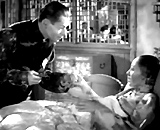 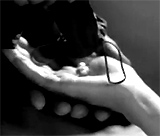 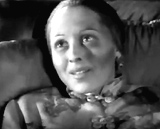  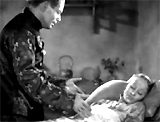 Return of Love and Pearls at Deathbed |
||||||
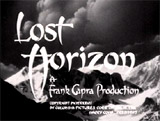
|
At film's end, in a fierce blizzard weather as they plodded along after leaving a remote Himalayan idyllic place known as Shangri-La, Maria's (Margo) face aged rapidly as she quickly reverted in appearance to her actual age. George Conway (John Howard) screamed out to his brother Robert (Ronald Colman) who was carrying Maria slung over his back:
Maria died an old wrinkled and withered woman (aging by half a century, the amount of time she had actually spent in the Shangri-La valley, although she hadn't aged there). George could not bear to see the decomposing body of the beloved woman and threw himself over the snowy cliffs. |
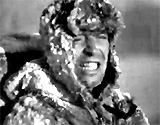 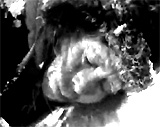 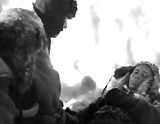 Aging and Death Upon Leaving Shangri-La |
||||||
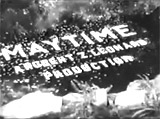
|
In this popular, sentimental MGM romantic operetta - the third of the profitable Jeanette MacDonald-Nelson Eddy films, the two star-crossed lovers were unable to consummate their love for each other, and they had to die in order to be reunited. Earlier in the film, international opera diva Marcia Mornay (Jeanette MacDonald) entered into a passionless and loveless marriage to her voice tutor/manager Nicolai Nazaroff (John Barrymore) while her real love affair was with penniless American singer-baritone Paul Allen (Nelson Eddy). When the two lovers happened to be performing together seven years later in New York's Metropolitan Opera, their spectacular rendition of the love duet Czaritza rose to a passionate crescendo as her jealous husband Nicolai looked on from the audience. As the two singers embraced and kissed during the opera's thunderous applause, she begged him: "Oh, don't ever leave me again, ever," and he vowed: "You're not going back to him. I'm taking you away tonight." After the performance, Marcia confessed her love for Paul to her husband, and requested for a divorce:
Although he appeared cooperative, the enraged Nicolai went to Paul's apartment and shot him to death. He died in Marcia's arms with his final dying words: "That day did last me all of my life. Don't cry, Marcia. You won't be lonely. I'll be close always." In the film's magnificent, bittersweet and sentimental closing scene, Marcia peacefully passed away in her home's garden. Her forever-youthful spiritual image rose from her body to meet and reunite with Paul's spirit singing to her within the garden gate with a reprise of their duet together: ("Sweetheart, Sweetheart, Sweetheart") "Will You Remember?": "Sweetheart, Sweetheart, Sweetheart, Though our paths may sever, To life's last faint ember, we will remember, Springtime, love time, May." The two lovers were reunited in death. The concluding images were of the spirits of Paul and Marcia in eternity on a path showered with flower blossoms. |
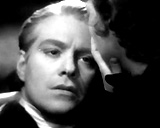 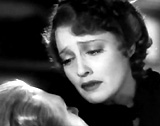 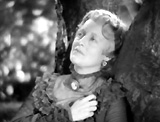 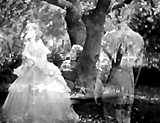 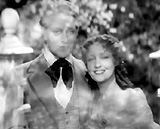
|
||||||
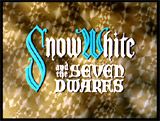
|
Snow White And The Seven Dwarfs (1937) Snow White 'died' after eating the poisoned apple, in the animated classic fairy-tale. She fell to the floor, the image of her hand extended as the bitten apple rolled on the floor. She fainted into a sleeping death, locked in a deep sleep only the kiss of love could break. The old hag/Wicked Queen (voice of Lucille La Verne) was jubilant with cackling laughter as lightning flashed:
In a classic confrontation between good and evil, the dwarfs pursued the Queen up into the mountains just as a raging storm broke out. Thinking she was trapped on a rocky crag ledge, she attempted to send a large boulder crashing down on the dwarfs. Amidst lightning and thunder bolts, lightning struck the crag she was perched on and it gave way. She plunged to her death in the memorable death scene. Two ominous, macabre vultures lurked above, followed the path of her fall, swooped off their perch and circled down to her crushed body. |
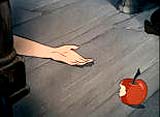 Snow White Biting Into The Poisoned Apple 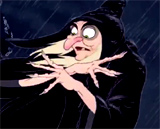 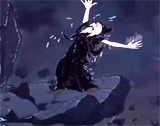 The Witch Plunging to Death |
||||||
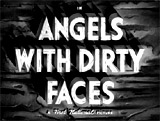
|
Angels with Dirty Faces (1938) In one of the most tautly directed, unforgettable, harrowing execution sequences of any film in the 1930s, Rocky Sullivan (James Cagney) was taken away for his last walk. The scene was bathed in dark suggestive, oppressive shadows, and the incredible musical score (by Max Steiner) resembled a plodding, relentless death march as he walked to his death. Rocky asks that long-time friend Father Jerry Connolly (Pat O'Brien) accompany him "going down the last mile." Still cocky and glaring with hatred, he snarled at and punched the sarcastic prison guard - it appeared that Rocky would be stoic to the end. Other prisoners on death row stared at the doomed man, bidding him goodbye through their jail cells. He shook Jerry's hand goodbye. In the final moments before his execution as he entered the death chamber, Rocky broke down and became "yellow" on his way to the electric chair. [It was unclear whether or not his true nature or motives were revealed - was he pretending or not?]. Rocky was transformed into a screaming, snivelling, cowering coward begging not to be killed. Awful, heart-rending screams of pathetic cowardice were heard. Seen only in large shadows projected on the wall, Rocky's cowardice was never fully revealed, except for his off-screen words:
Rocky's climactic cowardice brought tears to Father Connolly's eyes, who witnessed the execution (after two levers were activated). One of the guards noted: "The yellow rat was gonna spit in my eye." Grateful love filled Jerry's face - his prayers were answered. Rocky's yellow-ness in the face of the electric chair would kill the kids' unhealthy adoration, especially after reading the newspaper's headlines the next day:
|
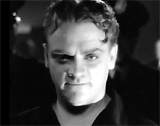 Rocky's March to Execution 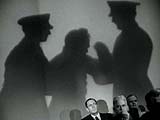 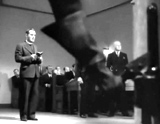 Death Row Shadows: "I don't wanna die." 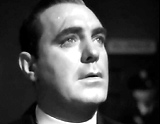 Father Connolly 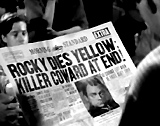
|
||||||
(chronological by film title) Intro | 1915-1929 | 1930-1933 | 1934-1938 | 1939 | 1940-1942 | 1943-1945 | 1946-1947 | 1948-1949 1950-1952 | 1953-1955 | 1956-1957 | 1958-1959 1960-1961 | 1962-1963 | 1964-1966 | 1967-1968 | 1969-1970 1971 | 1972 | 1973 | 1974 | 1975 | 1976 | 1977-1978 | 1979 1980 | 1981 | 1982 | 1983 | 1984 | 1985 | 1986 | 1987 | 1987 | 1988 | 1989 1990 | 1991 | 1992 | 1993 | 1994 | 1994 | 1995 | 1995 | 1996 | 1997 | 1998 | 1998 | 1999 2000-2001 | 2002 | 2003 | 2004 | 2005 | 2006 | 2007 | 2008 | 2009 | 2010 | 2011 |